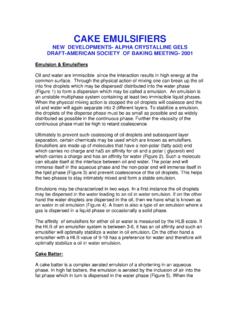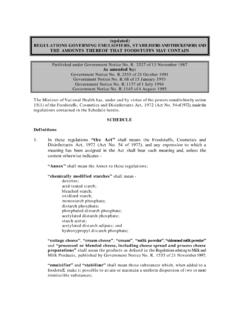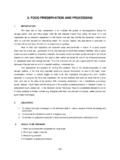Transcription of Personal Care - dewolfchem.com
1 Personal CareTechnical InformationJuly 2009 Supersedes issue dated March 200804_070801e-01/Page 1 of 10 Pluracare L/F GradesPoloxamer = Registered trademark of BASF groupChemical nature Poloxamer block copolymers are non ionic surfactants available under the Pluracare registered trade name. The Pluracare block copolymers (CAS-No. 9003-11-6) are synthetic copolymers of propylene oxide and ethylene oxide represented by the following chemical structure: Wherein a and b have the following values:PluracarePRDINCIabL 44 Surfactant30423781 Poloxamer 1241121L 64 G*30366560 Poloxamer 1841330L 64**30095899 Poloxamer 1841330F 68 G*30366561 Poloxamer 1887530F 68 Prill**30095850 Poloxamer 1887530F 127 Prill30089491 Poloxamer 40798 10156*not available in the US **only available in the US Specification See separate documents Standard Specification (not for regulatory purposes) available via BASF s WorldAccount: (registered access).
2 Properties The alphabetical designation explains the physical form of the product: L for liquid, F for solid forms. The first digit (two digits in a three-digit number) in the numerical designation, multiplied by 300, indicates the approximate molecular weight of the hydrophobic part of the molecule (propylene oxide). The last digit, when multiplied by 10, indicates the approx imate ethylene oxide content in the molecule. The approximate molecular weight of the hydrophobic part of the molecule (propylene oxide) is also indicated by the first 2 digits in the numerical designation of the INCI name, multiplied by 100. The last digit, when multiplied by 10, indicates the approx-imate ethylene oxide content in the molecule. NameINCIMw of PO part% of the EO partPluracare L 44 Poloxamer 124 4 x 300 = 12004 x 10 = 40 Pluracare L 64 Poloxamer 184 6 x 300 = 18004 x 10 = 40 Pluracare F 68 Poloxamer 188 6 x 300 = 18008 x 10 = 80 Pluracare F 127 Poloxamer 40712 x 300 = 36007 x 10 = 70 Pluracare L 44 Poloxamer 12412 x 100 = 12004 x 10 = 40 Pluracare L 64 Poloxamer 18418 x 100 = 18004 x 10 = 40 Pluracare F 68 Poloxamer 18818 x 100 = 18008 x 10 = 80 Pluracare F 127 Poloxamer 40740 x 100 = 40007 x 10 = 7004_070801e-01 July 2009 Page 2 of 10 Pluracare L/F Grades Poloxamer The block copolymers are anhydrous and no corrosive.
3 Therefore mild steel can be used for storage tanks, piping and conventional process equipment. Due to the non ionic character of the block copolymers they are miscible and compatible with almost all anionic as well as cationic surfactants. They do not react with cations such as Ca and Mg which are present in hard water. 04_070801e-01 July 2009 Page 3 of 10 Pluracare L/F Grades Poloxamer PluracareL 44L 64L 64 GF 68F 68 GF 127 Physical formliquid*liquidliquidpowderpowdersolid , Prill**Cloud point** (EN 1890)71 75 C method E58 62 C method A59 61 C method A100 C method A86 90 C method B< 100 C method AColor APHA (EN 1557, 70 C)max. 50max. 50max. 50max. 100max. 2 (Iodine color)max. 120% molecular weightappr. 2,200appr. 2,900appr. 2,900appr. 8,400appr. 8,400appr. 12,600 Density (DIN 51757, method A, 23 C)appr. g/cm3appr. g/cm3appr. g/cm3appr. (70 C)g/cm3appr.
4 (70 C) g/cm3appr. (70 C) g/cm3 Viscosity (EN 12092, 23 C, Brookfield, 60 rpm)appr. 440 mPa sappr. 850 mPa sappr. 850 mPa sappr. 1,000 (77 C) mPa sappr. 1,000 (77 C) mPa sappr. 3,100 (77 C) mPa sHLB12 1812 1812 18292918 23 Surface tension (DIN 53914, 1 g/l, 23 C)appr. 42 mN/mappr. 41 mN/mappr. 41 mN/mappr. 52 mN/mappr. 52 mN/mappr. 41 mN/mPour/Melt Point16 C16 C16 C52 C48 C56 C * the product is stabilized with 100 ppm Tocopherol ** the product is stabilized with 100 ppm BHT as antioxidant ** Cloud point according EN 1890 Method A: 1 g surfactant + 100 g distilled water Method B: 1 g surfactant + 100 g NaCl solution (c = 50 g/l) Method C: 1 g surfactant + 100 g NaCl solution (c = 100 g/l) Method D: 5 g surfactant + 45 g ethylene glycol monobutyl ether solution (c = 250 g/l) Method E: 5 g surfactant + 25 g ethylene glycol monobutyl ether solution (c = 250 g/l) Solubility of Pluracare surfactants in different vehiclesPluracare (Poloxamer)WaterEthanolIsopropanolMinera l OilEthylene GlycolPropylene GlycolL44 (124) YesYesYes NoNoYesL64 (184) YesYesYesNoNoYesF68 (188) YesYesNoNoNoNoF108 (338) YesYesNoNoNo<10%F127 (407) YesYesYesNoNoNo 04_070801e-01 July 2009 Page 4 of 10 Pluracare L/F Grades Poloxamer Applications It is suggested that these Pluracare copolymers be considered for their general functionality as surfactants, emulsifiers , solubilizers and stabilizers in almost all cosmetic preparations.
5 The Poloxamers boost the formation of well dispersed emulsions of usually not miscible liquids by changing the interfacial tension. They decrease the interfacial tension of cosmetic preparations and contribute to equal distribution during the of Suggested ApplicationsPluracare(Poloxamer)Highest water solubilityBest foamingBest de-tergencyMost effi-cient gel formationBest oil-in-water emulsifierBest solubilizerF127 (407) F68 G (188) L64 G (184) L44 (124) General use Major use Cosmetic ApplicationsProductFunctionUsePluracare L44(Poloxamer 124)Emulsifier (o/w)Liquid soap, cleansing water, make-up remover, cleansing wipes ..Pluracare L64/ L64 G(Poloxamer 184)Emulsifier (o/w),Co-emulsifier,Cleansing agentLiquid soap, cleansing water, skin care conditioner, lotions and cream preparations, make-up remover, direct hair dyeing ..Pluracare F68/ F68 G(Poloxamer 188)Solubilizer, Dispersant,Cleansing agent,Foam booster/stabilizerLiquid soap, cleansing water, skin care conditioner, make-up remover, deo dorant sticks, cake eyeliner, mouthwash.
6 Pluracare F127/ F127 NF(Poloxamer 407)Solubilizer, Gelling agentToothpaste, whitening gels, mouthwash, Sun and Skin care applications, .. Pluracare L 44 Due to the low skin and eye irritation Pluracare L 44 find particular application in skin care such as liquid soaps, cleansing wipes or make-up removers. However it is also used as an emulsifier (o/w or w/o) in a wide variety of areas from cosmetics to oral care products. Pluracare L 64 G Pluracare L 64 Pluracare L 64/L 64 G has the highest cleansing activity of the available Poloxamers. Therefore and due to the low skin and eye irritation Pluracare L 64/L 64 G is mainly used as cleanser in mild facial products such as make-up cleansing wipes but also in color cosmetics. It also finds application as o/w emulsifier. Pluracare F 68 G Pluracare F 68 Pluracare F 68/F 68 G has the best foaming properties of the available Poloxamers.
7 Therefore it is mainly used in shower gels, washing foams, shaving gels but also in oral care applications such as toothpastes or mouthwash products. It easily solubilizers perfume oils. Pluracare F 127 Pluracare F 127 is used as thickener, gelling agent, coemulsi fier, and bodying agent in toothpastes, mouthwashes, creams and liquid emul sions. Another application is as a solubilizer for certain active substances and essential oils in cosmetic pre-parations. 04_070801e-01 July 2009 Page 5 of 10 Pluracare L/F Grades Poloxamer Rheological properties Dilute aqueous solutions display Newtonian flow, which is transformed into plastic flow with a pronounced change in flowability at concentrations above about 10% (Fig. 1). Fig. 1: Flow of 10% and 25% aqueous Pluracare F 127 gels Fig. 2: Viscosity of a 25% aqueous Pluracare F 127 gel as a function of temperature Electrolytes, humectants, alcohols, surfactants, and other additives affect the viscosity of Pluracare F 127 gels.
8 For instance, sodium chloride lowers the gel formation temper ature, and increases the viscosity. Sensitivity to electrolytes does not occur until the addition rate of sodium chloride reaches 20% (Fig. 3). Ethanol, on the other hand, raises the gel formation temperature. Incompatibility arises with anionic surfactants and at low pH values. Fig. 3: Viscosity of 25% aqueous Pluracare F 127 gel for various addition rates of sodium chloride 04_070801e-01 July 2009 Page 6 of 10 Pluracare L/F Grades Poloxamer Preparation of gels Gels can be prepared by two methods. 1. Cold-water process Pluracare F 127 is stirred into water at about 5 C. Gelling sets in on heating to room temperature. 2. Hot-water process The Pluracare F 127 is dissolved in hot water. The gel is formed when the solution cools to room temperature. In principle, both methods yield gels with the same proper ties. However, lumps are formed when the Pluracare F 127 is mixed into the hot aqueous phase, and the solutions may have to stand for several hours before the lumps disappear.
9 For this reason, we recommend the cold-water process for the production of gels. In order to avoid the formation of air bubbles, a vacuum should be applied before heating, before the gel is When formulating these surfactants into aqueous systems, always introduce the surfactant into the water slowly and with mild agitation. This procedure will minimize the potential for gellation to occur. Stability/Storage The Pluracare block copolymers should be stored in a cool, dark place. Low storage temperature (<15 C) can lead to congealing, turbidity or sedimentation which is reversible at 50 60 C. In case of any inhomogenicity the product should be heated with or without stirring to 50 60 C before use. Pluracare F 68 G/F 68 and F 127 should not be stored over 30 C. The products are hygroscopic so that we recommend resealing opened drums under total air exclusion. The recommended shelf life of these materials is two years from the date of manu-facture when stored in the original sealed containers.
10 Material over two years old should be checked for quality before use. Typical formulations 04_070801e-01 July 2009 Page 7 of 10 Pluracare L/F Grades Poloxamer Mascara*No. 67/00013%IngredientsSupplierINCI , F 127(1)Poloxamer K 30(1) care (1) 934(6) , Black 80 E 172(1)C. I. 77 499, Iron Oxides Production:Solubilize the components of phase A. Dissolve phase B and stir it into phase A. Stir phase C into the solution of the combined phases A and B and homogenize :Viscosity: 30,000 mPa s pH value: appr. 7 *Please note: formulation not approved in Japan04_070801e-01 July 2009 Page 8 of 10 Pluracare L/F Grades Poloxamer Handwash with instant foamNo. 52/00101%IngredientsSupplierINCI F 68 G(1)Poloxamer UltraCare(1)Polyquaternium 87%(20) Betain L 7(44)Cocamidopropyl :Heat ingredients of phase A to 80 ingredients of phase B and stir till everything is completely to 40 C while stirring, add ingredients of phase C and stir to get a clear ingredients of phase slowly the mixture from phase D to the mixture of the phases A + B + C and stir to :pH value: Make up removerNo.







